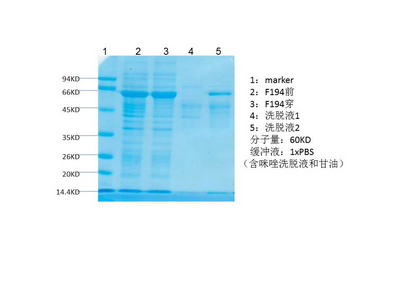- Home
- About
- Promotions
-
Products
-
Elisa Kits
- |
-
Primary antibodies
- |
-
Secondary antibodies
- |
-
Proteins
- |
-
IHC reagents
- |
-
WB reagents
- PonceauS Staining Solution
- PBST Washing Buffer, 10X
- 1.5M Tris-HCl Buffer, pH8.8
- 1M Tris-HCl Buffer, pH6.8
- 10% SDS Solution
- Prestained Protein Marker
- TBST Washing Buffer, 10X
- SDS PAGE Loading Buffer, 5X
- Stripping Buffered Solution
- Tris Buffer, pH7.4, 10X
- Total Protein Extraction Kit
- Running Buffer, 10X
- Transfer Buffer, 10X
- 30% Acr-Bis(29:1) Solution
- Tris电泳液速溶颗粒
- PBS(1X, premixed powder)
- TBS(1X, premixed powder)
- 快速封闭液
- 转膜液速溶颗粒
- Chemical reagents
- News
- Distributor
- Resources
- Contact
- Home
- >
- Info
- >
- MEK4 protein
- >
- Go Back
MEK4 protein
- Catalog No.:YD0068
- Applications:WB;SDS-PAGE
- Reactivity:Human
- Protein Name:
- MEK4 protein
- Sequence:
- Amino acid: 218-362, with his-MBP tag.
- Formulation:
- Liquid in PBS
- Concentration:
- SDS-PAGE >90%
- Storage Stability:
- -20°C/6 month,-80°C for long storage
- Other Name:
- Dual specificity mitogen-activated protein kinase kinase 4 (MAP kinase kinase 4) (MAPKK 4) (EC 2.7.12.2) (JNK-activating kinase 1) (MAPK/ERK kinase 4) (MEK 4) (SAPK/ERK kinase 1) (SEK1) (Stress-activated protein kinase kinase 1) (SAPK kinase 1) (SAPKK-1) (SAPKK1) (c-Jun N-terminal kinase kinase 1) (JNKK)
- Background:
- catalytic activity:ATP + a protein = ADP + a phosphoprotein.,function:Dual specificity kinase that activates the JUN kinases MAPK8 (JNK1) and MAPK9 (JNK2) as well as MAPK14 (p38) but not MAPK1 (ERK2) or MAPK3 (ERK1).,PTM:Activated by phosphorylation on Ser/Thr by MAP kinase kinase kinases.,similarity:Belongs to the protein kinase superfamily.,similarity:Belongs to the protein kinase superfamily. STE Ser/Thr protein kinase family. MAP kinase kinase subfamily.,similarity:Contains 1 protein kinase domain.,subunit:Interacts with SPAG9.,tissue specificity:Abundant expression is seen in the skeletal muscle. It is also widely expressed in other tissues.,
- Function:
- MAPKKK cascade, protein amino acid phosphorylation, phosphorus metabolic process, phosphate metabolic process,intracellular signaling cascade, protein kinase cascade, JNK cascade, phosphorylation, stress-activated protein kinase signaling pathway, cellular response to stress,
- Subcellular Location:
- Cytoplasm . Nucleus .
- Expression:
- Abundant expression is seen in the skeletal muscle. It is also widely expressed in other tissues.




